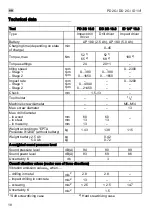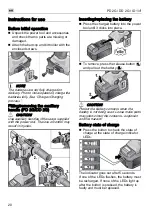
PD 2G / DD 2G / ID 1/4"
17
Only use the charger in dry rooms and
avoid all contact with moisture and rain.
The ingress of water into the charger
increases the risk of electric shock.
Never use the charger if cables, plugs or
the device itself are damaged as a result
of external influence. Take the charger to
the nearest authorised repair shop.
Under no circumstances open the
charger. In the event of a fault, take it to an
authorised repair shop.
Do not place any objects on the charger
and do not place the charger on soft
surfaces. Fire hazard!
Special safety instructions
Use only original batteries with the
voltage indicated on the type plate of
your power tool. The use of other
batteries, e.g. imitations, reconditioned
batteries or other makes, increases the risk
of injury and damage to property by
exploding batteries.
Recharge batteries only with chargers
recommended by the manufacturer. A
charger that is suitable for one type of
battery may create a fire hazard when used
with another battery.
The battery may be damaged by pointed
objects such as e.g. nails or screwdrivers
or by external application of force. This
may give rise to an internal short circuit,
causing the battery to burn, smoke,
explode or overheat.
Before carrying out any work on the
power tool, move the direction
preselector switch (2) to the middle
position.
Operate the direction preselector switch
(2) or torque setting turning dial (5) only
when the tool is stopped.
Identify the power tool with stickers only.
Do not drill any holes into the housing.
Noise and vibration
The noise and vibration values have been
determined in accordance with EN 60745.
NOTE
The values are set out in the “Technical
data” table.
WARNING!
The indicated measurements refer to new
power tools. Daily use causes the noise and
vibration values to change.
NOTE
The vibration emission level given in this
information sheet has been measured in
accordance with a measurement method
standardised in EN 60745 and may be used
to compare one tool with another. It may be
used for a preliminary assessment of
exposure. The specified vibration emission
level represents the main applications of the
tool. However, if the tool is used for different
applications, with different cutting accessories
or poorly maintained, the vibration emission
level may differ.
This may significantly increase the
exposure level over the total working period.
To make an accurate estimation of the
vibration exposure level, it is also necessary to
take into account the times when the tool is
switched off or running but not actually in use.
This may significantly decrease the exposure
level over the total working period.
Identify additional safety measures to protect
the operator from the effects of vibration such
as: maintain the tool and the cutting
accessories, keep the hands warm,
organisation of work patterns.
CAUTION!
Wear ear defenders at a sound pressure
above 85 dB(A).










































